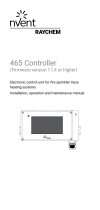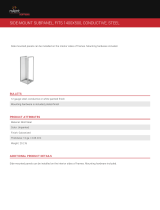
© 2022 nVent 89115088
- 2 -
NOTE: Some of the information in this manual may not apply if a special unit was ordered. If
additional drawings for a special unit are necessary, they have been inserted. Contact nVent
Equipment Protection if further information is required.
WARRANTY AND RETURN POLICY
https://hoffman.nvent.com/en/hoffman/warranty-information
TABLE OF CONTENTS
WARRANTY AND RETURN POLICY ................................................................................................................................................ 2
RECEIVING THE AIR CONDITIONER ............................................................................................................................................... 3
HANDLING AND TESTING THE AIR CONDITIONER ...................................................................................................................... 3
INSTALLATION INSTRUCTIONS ..................................................................................................................................................... 4
Design Data ..................................................................................................................................................................................................... 4
Dimensional Drawings ................................................................................................................................................................................... 5
115/230 Volt ........................................................................................................................................................................................... 5
460 Volt .................................................................................................................................................................................................... 6
Mounting Cutout Dimensions ........................................................................................................................................................................ 7
Components List ............................................................................................................................................................................................ 7
Wire Diagrams ................................................................................................................................................................................................. 8
Mechanical Thermostat Unit, 115/230V .............................................................................................................................................. 8
Mechanical Thermostat Unit, 460V ....................................................................................................................................................... 9
Schematic ..................................................................................................................................................................................................... 10
Mechanical Thermostat Unit ............................................................................................................................................................... 10
Wire Diagrams ............................................................................................................................................................................................... 11
Remote Digital Controller Unit, 115/230V .......................................................................................................................................... 11
Remote Digital Controller Unit, 460V .................................................................................................................................................. 12
TEMPERATURE CONTROL FOR MECHANICAL THERMOSTAT UNIT .......................................................................................13
Units With heat .............................................................................................................................................................................................. 13
General Information .............................................................................................................................................................................. 13
Example ................................................................................................................................................................................................. 13
To change the temperature setting of the thermostat ...................................................................................................................... 13
Dial ranges ............................................................................................................................................................................................. 13
Testing thermostat calibration ............................................................................................................................................................ 13
PRINCIPLES OF OPERATION ........................................................................................................................................................ 14
MAINTENANCE ..............................................................................................................................................................................14
Compressor................................................................................................................................................................................................... 14
Inlet Air Filter ................................................................................................................................................................................................. 14
How To Remove, Clean or Install a New Inlet Air Filter ............................................................................................................................. 15
Condenser and Evaporator Air Movers ....................................................................................................................................................... 15
Refrigerant Loss............................................................................................................................................................................................ 15
TROUBLE SHOOTING ....................................................................................................................................................................16
Basic Air Conditioning Trouble Shooting Check List ................................................................................................................................. 16
Symptoms and Possible Causes: ............................................................................................................................................................... 17
F-GAS INFORMATION ....................................................................................................................................................................17



























